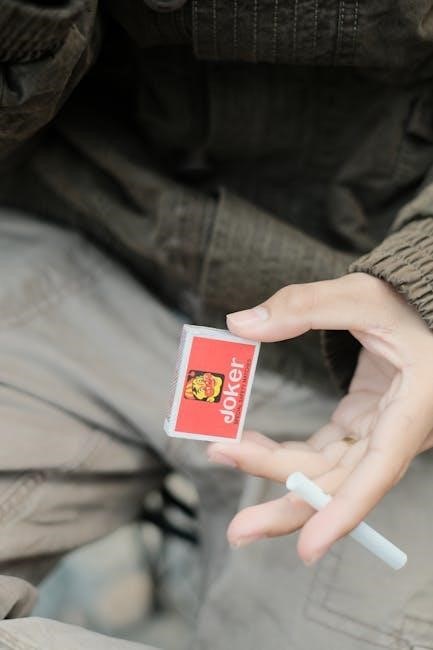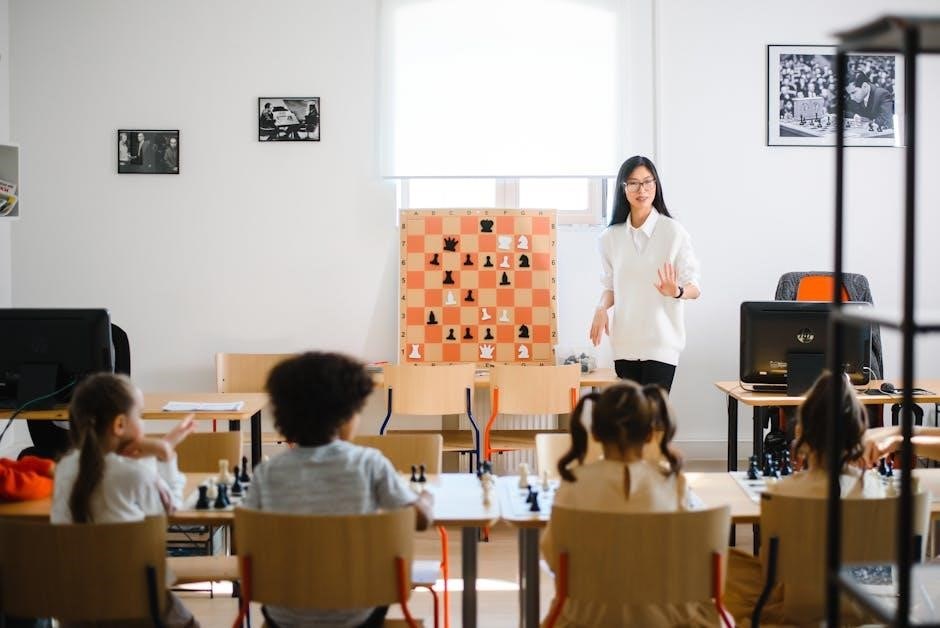matchstick puzzles with answers pdf

Matchstick puzzles are engaging brain teasers that challenge spatial awareness and logical thinking. Using matchsticks to form equations or shapes, these puzzles offer fun, educational exercises for all ages.
What Are Matchstick Puzzles?
Matchstick puzzles are brain-teasers that use matchsticks to form shapes, numbers, or letters. These puzzles often require rearranging, adding, or removing sticks to solve a visual or arithmetic challenge. They can be presented as equations, where numbers are represented by matchstick formations, or as geometric shapes that need to be transformed. The goal is to manipulate the sticks to achieve a specific outcome, such as balancing an equation or creating a symmetrical figure. Matchstick puzzles are popular for their simplicity and ability to engage both children and adults. They typically involve a small number of sticks, making them accessible but still challenging. By focusing on logic and creativity, these puzzles provide entertainment while sharpening problem-solving skills.
Additionally, matchstick puzzles with answers in PDF format are widely available, offering a convenient way to practice and learn. These resources often include a variety of puzzles, ranging from basic to complex, along with solutions to help learners improve their techniques. Whether found in books, online platforms, or printable sheets, matchstick puzzles with answers are a great tool for anyone looking to enhance their logical thinking and spatial reasoning abilities.
Why Are Matchstick Puzzles Popular?
Matchstick puzzles are popular due to their simplicity and universal appeal, making them accessible to all ages. They provide an engaging challenge that stimulates logical and creative thinking, enhancing problem-solving skills. Their availability in PDF formats with answers adds convenience, allowing easy access and practice. Nostalgia also plays a role, as many enjoy revisiting childhood activities. Additionally, they serve as a cost-effective, versatile form of entertainment, suitable for both individual enjoyment and collaborative settings. The tactile nature of matchstick puzzles offers a refreshing analog activity in a digital age, while their community-driven sharing and solving further boost their popularity. Overall, their enduring appeal lies in their balance of simplicity, challenge, and cognitive benefits.

History and Evolution of Matchstick Puzzles
Matchstick puzzles originated in the mid-20th century, evolving from simple challenges in newspapers to complex designs. Their popularity grew with the introduction of numbers and letters, enabling mathematical and word-based puzzles. Today, matchstick puzzles are widely shared in PDF formats, making them easily accessible for all skill levels. This evolution reflects their enduring appeal as a versatile and engaging problem-solving activity.
Early Beginnings of Matchstick Puzzles
Matchstick puzzles trace their origins to the early 20th century, emerging as simple yet engaging brain teasers. Initially, they involved rearranging matchsticks to form equations or shapes, often published in newspapers and magazines. These puzzles quickly gained popularity due to their accessibility and the minimal materials required—just matchsticks and a flat surface. The concept was further popularized by puzzlemasters who created increasingly complex challenges. Early examples focused on basic arithmetic and geometric shapes, laying the foundation for modern variations. The introduction of numbers and letters expanded their scope, allowing for both mathematical and word-based puzzles. This early innovation paved the way for matchstick puzzles to become a staple in recreational problem-solving, eventually leading to their widespread distribution in PDF formats for easy access.
Modern Variations and Innovations
Modern matchstick puzzles have evolved significantly, incorporating new themes, designs, and technologies. Digital versions now offer interactive solutions, allowing users to manipulate matchsticks virtually. Themed puzzles, such as seasonal or holiday-based challenges, add variety and appeal to a broader audience. Innovations include 3D matchstick puzzles, requiring players to think beyond flat surfaces. Additionally, the integration of riddles and wordplay has expanded their complexity. PDF formats now often include hints, solutions, and multiple difficulty levels, making them more user-friendly. These advancements ensure matchstick puzzles remain relevant and engaging in the digital age, appealing to both traditional enthusiasts and new generations of problem-solvers. Their adaptability continues to drive their popularity as a timeless intellectual pastime.

Types of Matchstick Puzzles
Matchstick puzzles come in various forms, including arithmetic, wordplay, and geometry-based challenges, often available in PDFs with answers for easy solving and learning.
Equation-Based Matchstick Puzzles
Equation-based matchstick puzzles are a popular type where matchsticks are arranged to form numbers or mathematical symbols, creating arithmetic challenges. These puzzles often present equations that don’t add up, requiring players to move or add matchsticks to balance the equation. For example, a puzzle might show 6 + 2 = 7, and the solution could involve rearranging sticks to make 6 + 2 = 8 by adding a matchstick to the equals sign. These puzzles are great for improving logical thinking and problem-solving skills. Many printable PDFs with answers are available online, offering a variety of difficulty levels and solutions. They are ideal for both casual enthusiasts and educational purposes, providing a fun way to practice math and creativity.
Shape-Based Matchstick Puzzles
Shape-based matchstick puzzles challenge players to arrange matchsticks into specific geometric shapes or recognizable objects. These puzzles often involve creating symmetrical figures like squares, triangles, or more complex forms. For example, a puzzle might require forming a three-dimensional cube using a set number of matchsticks. Some variations involve transforming one shape into another by moving a limited number of sticks, enhancing spatial awareness and creativity. Printable PDFs with answers are widely available, offering a range of difficulty levels and solutions. These puzzles are particularly effective for improving problem-solving skills and logical thinking. They provide a fun and engaging way to enhance spatial reasoning and creativity, making them suitable for both children and adults. Many educational resources include these puzzles to foster visual and cognitive development.

How to Solve Matchstick Puzzles
Start by analyzing the problem and counting matchsticks. Visualize possible configurations and move sticks to form the desired shape or equation. Practice improves skills over time.
Basic Strategies for Solving Matchstick Puzzles
Begin by carefully studying the puzzle to understand the goal. Look for symmetry or patterns that can simplify the problem. Count the total number of matchsticks to ensure no pieces are added or removed. Experiment by moving one stick at a time to test potential configurations. Pay attention to shapes or letters that can be formed by rearranging sticks. Practice logical thinking and patience, as these puzzles often require creative solutions. For equation-based puzzles, focus on balancing numbers by moving or repositioning sticks. Spatial awareness is key, so visualize the puzzle from different angles. Use resources like matchstick puzzle PDF guides for examples and tips to refine your approach. Consistent practice will enhance your problem-solving skills and speed.
Common Mistakes to Avoid
When solving matchstick puzzles, avoid rushing or assuming only one solution exists. A common mistake is moving too many sticks at once, which can complicate the problem. Many players overlook the importance of counting total sticks to ensure none are added or removed. Others fail to consider that some puzzles require breaking or combining sticks creatively. Overcomplicating the problem or ignoring simple shapes is another frequent error. Additionally, players often forget to double-check their solutions for accuracy. Patience and attention to detail are crucial. By avoiding these pitfalls, you can improve your problem-solving efficiency and enjoyment of matchstick puzzles. Practicing regularly will help you recognize and avoid these mistakes, leading to better outcomes.

Matchstick Puzzle Difficulty Levels
Matchstick puzzles range from simple to complex, catering to all skill levels. Easy puzzles involve basic arithmetic, while advanced ones require creative problem-solving and lateral thinking.
Easy Matchstick Puzzles for Beginners
Easy matchstick puzzles are designed to introduce newcomers to the concept of problem-solving with matchsticks. These puzzles typically involve simple arithmetic or geometric shapes, requiring minimal moves to solve. For example, rearranging matchsticks to form a valid equation or creating symmetrical figures. They are an excellent way to build foundational skills and confidence. Many easy puzzles are available in PDF formats, complete with answers, allowing beginners to practice and learn at their own pace. These puzzles often focus on basic principles, such as balance, symmetry, and logical reasoning. By mastering these, beginners can gradually progress to more challenging problems. Easy matchstick puzzles are a fun and engaging way to develop critical thinking skills while enjoying a creative mental exercise.
Advanced Matchstick Puzzles for Experts
Advanced matchstick puzzles are tailored for experienced solvers, offering complex challenges that demand refined problem-solving skills. These puzzles often involve intricate configurations, such as forming multiple objects with a fixed number of matchsticks or solving equations with unconventional solutions. Experts enjoy the intellectual stimulation of these puzzles, which require precise spatial reasoning and creativity. Many advanced puzzles are available in PDF formats, complete with answers, allowing experts to test their abilities and refine their strategies. These puzzles often push the boundaries of logical thinking, incorporating lateral thinking and innovative approaches. Solving advanced matchstick puzzles enhances cognitive agility and problem-solving precision, making them a rewarding challenge for skilled enthusiasts. They are an excellent way to keep the mind sharp and explore the limits of matchstick puzzle creativity.

Educational Benefits of Matchstick Puzzles
Matchstick puzzles with answers in PDF format provide structured learning tools, enhancing problem-solving skills and logical reasoning. They offer clear solutions, helping users verify their progress and understand mistakes.
Improving Logical Thinking and Problem-Solving Skills
Matchstick puzzles are excellent tools for enhancing logical thinking and problem-solving abilities. By rearranging matchsticks to form equations or shapes, individuals develop critical thinking skills. These puzzles require a systematic approach, encouraging players to analyze patterns and explore different possibilities. Solving them fosters analytical reasoning and spatial awareness, which are essential for tackling real-world problems. Regular practice with matchstick puzzles can improve cognitive flexibility, allowing individuals to think creatively and outside the box. The challenge of finding the correct configuration sharpens mental focus and persistence. Additionally, these puzzles are often used in educational settings to help students develop logical reasoning from a young age. The availability of matchstick puzzles with answers in PDF format makes it easier for learners to track their progress and refine their problem-solving strategies.
Enhancing Spatial Awareness and Creativity
Matchstick puzzles are an excellent tool for enhancing spatial awareness and fostering creativity. By manipulating matchsticks to form shapes or equations, individuals develop a stronger understanding of spatial relationships and visual perception. These puzzles challenge the brain to think outside the box, encouraging creative problem-solving skills. As users visualize and rearrange matchsticks, they improve their ability to mentally rotate objects and explore multiple configurations. This cognitive exercise not only sharpens spatial reasoning but also boosts imagination, as players often discover innovative solutions. Additionally, matchstick puzzles with answers in PDF format provide a structured way to practice these skills, making them a valuable resource for both recreational and educational purposes. Regular engagement can lead to enhanced creativity and a more adaptable thinking style.

Matchstick Puzzles with Answers in PDF Format
Matchstick puzzles with answers in PDF format are widely available online, offering convenient printing and solving. Popular resources include educational websites and puzzle forums.
Where to Find Printable Matchstick Puzzles
Discovering printable matchstick puzzles with answers is easier than ever, thanks to the abundance of online resources. Websites dedicated to brain teasers and logic games often feature downloadable PDFs containing matchstick puzzles. Educational platforms and puzzle communities also offer free resources for both kids and adults. Additionally, creative platforms like Pinterest and Etsy provide beautifully designed matchstick puzzle sheets. Many puzzle books available in digital formats include matchstick puzzles with solutions. When searching, use keywords like “matchstick puzzles PDF” or “printable matchstick puzzles with answers” to find the best options. Always ensure the source is reputable to guarantee high-quality puzzles and correct solutions.
Downloading and Using Matchstick Puzzle PDFs
Matchstick puzzle PDFs are a convenient way to access a wide variety of puzzles with solutions included. These files are often available for free on educational websites, puzzle forums, and creative platforms. To download them, simply search for “matchstick puzzles with answers PDF” and choose a reliable source. Once downloaded, you can print the puzzles or solve them digitally using a PDF viewer. Many PDFs are designed for both beginners and advanced solvers, offering a range of difficulty levels. Some files also include tips and strategies to help improve problem-solving skills. Organize your collection by creating folders or renaming files for easy access. This format makes it ideal for sharing with friends or using in classroom settings.

Advanced Techniques for Matchstick Puzzles
Advanced techniques involve visual restructuring and creative matchstick manipulation. Experts often explore negative space and alternative perspectives. These methods enhance problem-solving efficiency and foster innovation in puzzle design.
- Visual restructuring: Seeing beyond obvious shapes;
- Negative space analysis: Utilizing empty areas effectively.
- Alternative perspectives: Rotating or flipping configurations.
These strategies, often detailed in matchstick puzzle PDF guides, challenge solvers to think creatively and push boundaries of traditional problem-solving approaches;
Using Lateral Thinking in Matchstick Puzzles
Lateral thinking is a crucial skill in solving matchstick puzzles, as it encourages creative problem-solving. Unlike traditional logic, which follows a linear path, lateral thinking involves reimagining the puzzle’s structure and rules. For example, a matchstick equation might require moving or repurposing sticks in unconventional ways, such as rotating the entire puzzle or breaking apart seemingly fixed shapes. This approach often leads to unexpected yet correct solutions.
Practitioners of lateral thinking in matchstick puzzles often explore alternative perspectives, such as altering the orientation of the puzzle or interpreting numbers and symbols differently. This mindset not only enhances creativity but also sharpens problem-solving abilities. By embracing lateral thinking, solvers can overcome seemingly insurmountable challenges and unlock innovative solutions.
Exploring Multiple Solutions
One of the fascinating aspects of matchstick puzzles is the possibility of discovering multiple solutions. While some puzzles have a single, definitive answer, others can be solved in various ways, encouraging creativity and critical thinking. For example, a puzzle involving matchstick equations might allow for different arrangements of numbers and symbols to achieve the same result. Similarly, shape-based puzzles might permit multiple configurations that satisfy the problem’s conditions.
- Exploring multiple solutions enhances problem-solving skills.
- It fosters lateral thinking and creativity.
- Some puzzles are intentionally designed to have more than one answer.
By examining each matchstick’s role and experimenting with different arrangements, solvers can uncover alternative solutions. This process not only deepens understanding but also makes the puzzle-solving experience more engaging and rewarding. Resources like matchstick puzzle PDFs often include examples with multiple solutions, allowing practitioners to challenge themselves further.

Popular Examples of Matchstick Puzzles
Classic matchstick puzzles include the “EQUATIONS” puzzle, where matchsticks form numbers in equations, and the “SQUARE TO TRIANGLE” puzzle, challenging spatial reasoning. These puzzles, often found in PDF collections, provide engaging brain teasers for all skill levels, with solutions included for easy verification and learning.
- The “EQUATIONS” puzzle: Solve math problems using matchstick numbers.
- The “SQUARE TO TRIANGLE” puzzle: Rearrange matchsticks to form different shapes.
Classic Matchstick Equations
Classic matchstick equations are among the most recognizable and enduring examples of matchstick puzzles. These puzzles typically involve rearranging a set number of matchsticks to form valid arithmetic equations. A well-known example is the equation XC = LIII + III, where the challenge is to move just one matchstick to make the equation correct. Another classic is II = IV, requiring a clever rearrangement of matches to balance the equation.
These puzzles are popular due to their simplicity and the logical thinking they require. They often rely on visual trickery, such as rotating matches or interpreting them differently. Many classic matchstick equations are widely shared in matchstick puzzles with answers PDF formats, making them easily accessible for practice and enjoyment. Solving these timeless puzzles is a great way to sharpen problem-solving skills while having fun.
Unique and Tricky Matchstick Configurations
Matchstick puzzles often feature unique and tricky configurations that challenge solvers to think creatively. These puzzles might involve arranging matches into complex shapes or equations where the solution requires moving or repositioning only a few sticks. For example, a puzzle might present a seemingly impossible equation, such as 6 = 3, where the solution involves rotating or flipping matches to reveal the answer. Similarly, some puzzles use matches to form letters or numbers, requiring solvers to reinterpret the structure entirely. These configurations test problem-solving skills, as they often rely on lateral thinking rather than straightforward logic. Solving such puzzles can be rewarding, especially when the solution involves an unexpected twist. Printable PDFs with answers provide a great way to practice these challenging configurations and improve puzzle-solving abilities.

Matchstick Puzzles for Kids and Adults
Matchstick puzzles are perfect for both kids and adults, promoting problem-solving skills and creativity. They cater to all ages, making them a great family activity.
Age-Appropriate Matchstick Puzzles
Matchstick puzzles can be tailored to suit different age groups, ensuring they are both fun and challenging. For younger children, puzzles with simple shapes and bright colors are ideal, as they help develop basic problem-solving skills. Older kids and teenagers can tackle more complex designs, such as 3D structures or math-based puzzles, which enhance spatial reasoning and logical thinking. Adults can also enjoy these puzzles, using them as a mental exercise or stress-relief activity. Many printable matchstick puzzles with answers in PDF format are designed with age-specific difficulty levels, making them accessible to a wide range of learners. This versatility ensures that matchstick puzzles remain engaging and educational for people of all ages.
Using Matchstick Puzzles in Educational Settings
Matchstick puzzles are an excellent tool for enhancing cognitive skills in educational environments. Teachers can incorporate them into lesson plans to promote problem-solving and logical reasoning. These puzzles are particularly effective in math and science classes, as they encourage students to think creatively about geometric shapes and numerical relationships. For younger students, matchstick puzzles can be used to develop fine motor skills and hand-eye coordination. In group settings, they foster collaboration and teamwork, as students work together to find solutions. Additionally, matchstick puzzles can be adapted to different difficulty levels, making them suitable for a wide range of learners. Many educational institutions now offer matchstick puzzle resources in PDF formats, making it easy for teachers to print and distribute them in the classroom. This approach not only engages students but also provides a fun way to learn essential problem-solving techniques.
Matchstick puzzles with answers in PDF format provide clear solutions, helping enthusiasts improve problem-solving skills and logical thinking. They serve as excellent resources for learners of all ages, encouraging others to explore and enjoy these brain-teasers.
Final Thoughts on Matchstick Puzzles
Matchstick puzzles are a delightful and engaging way to challenge the mind while fostering creativity. Their simplicity, using just matchsticks and logic, makes them accessible to all ages. Whether you’re solving classic equations or tackling intricate shapes, these puzzles offer hours of entertainment and mental stimulation. The availability of matchstick puzzles with answers in PDF format has made it easier than ever to practice and improve problem-solving skills. These resources are especially valuable for educators and parents seeking fun, educational activities. By embracing matchstick puzzles, you not only sharpen your logical thinking but also cultivate patience and perseverance. So, dive into the world of matchstick puzzles, explore their endless possibilities, and enjoy the rewarding experience of solving these clever brain teasers!
Encouraging Others to Try Matchstick Puzzles
Introducing others to matchstick puzzles can be a rewarding experience, as it fosters cognitive development and teamwork. Start by highlighting the fun and challenging nature of these puzzles, emphasizing how they sharpen problem-solving skills. Share simple examples or PDFs with answers to demonstrate their accessibility. Encourage beginners by celebrating small successes, which builds confidence. Collaborative solving can also make the activity enjoyable, turning it into a bonding experience. Emphasize that matchstick puzzles are suitable for all ages and skill levels, making them a great hobby for families or groups. By showcasing the creative and logical aspects, you can inspire others to give matchstick puzzles a try. Remember, persistence and practice lead to improvement, so motivate others to keep exploring these engaging brain teasers.